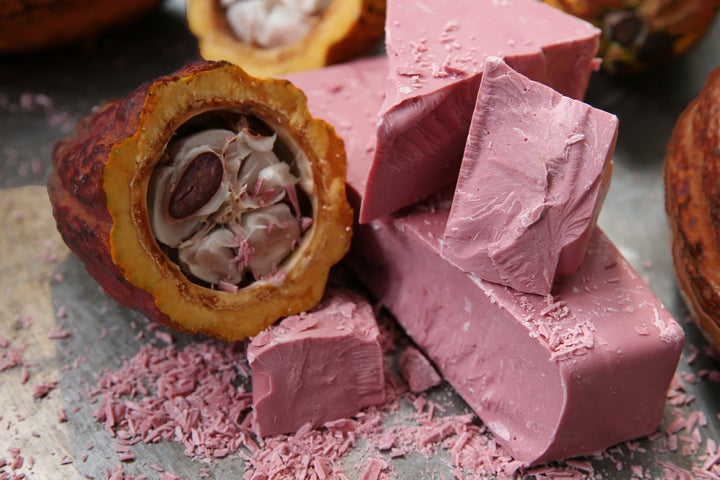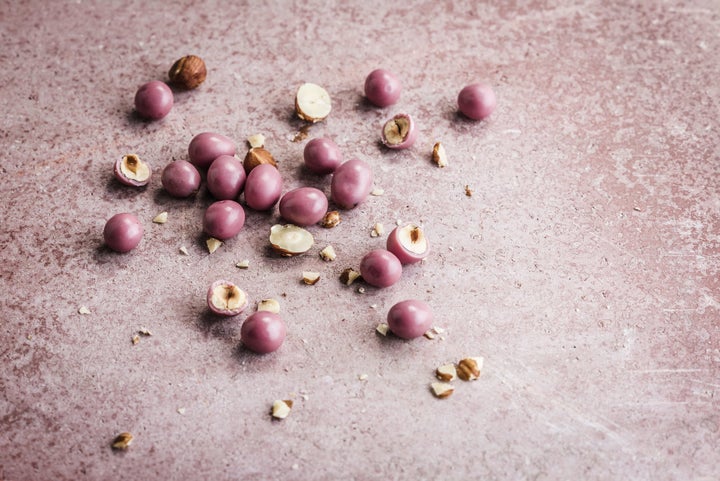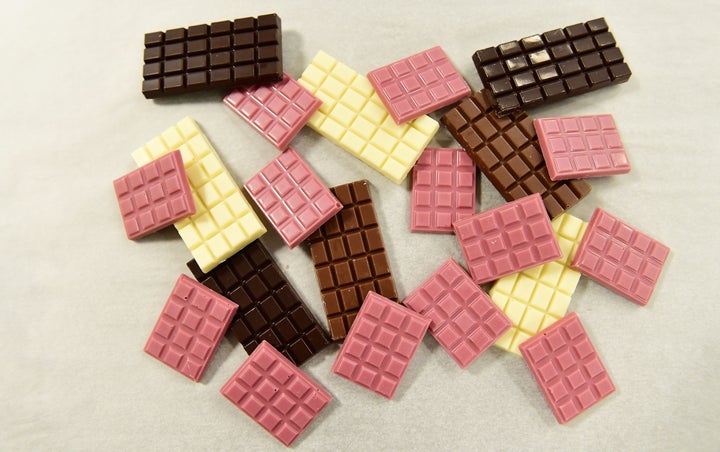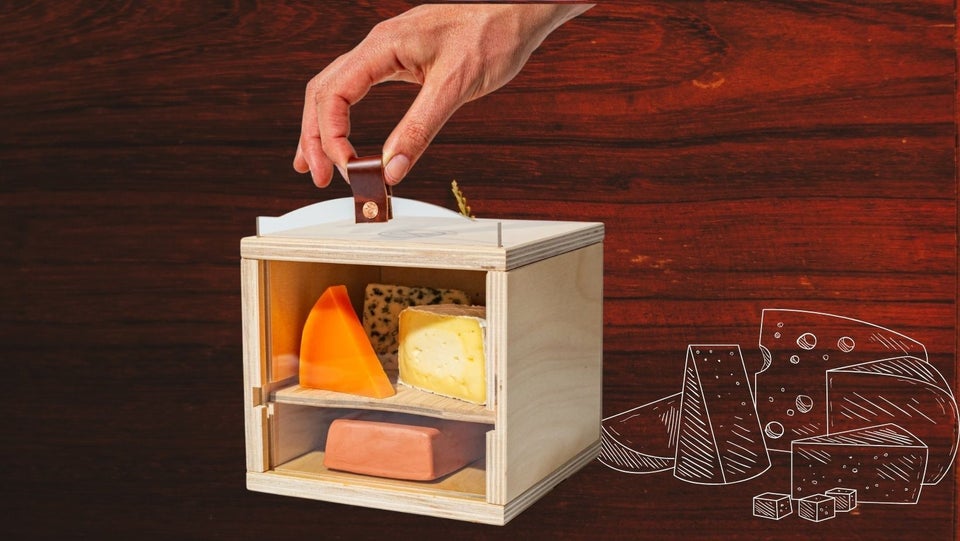
Like many baking novices, I’ve learned about a lot of new ingredients and techniques from “The Great British Bake Off.” But perhaps the most interesting (and aesthetically pleasing) tidbit I’ve seen on the show is “ruby chocolate.”
During the 2020 season, contestant Sura Selvarajah baked dark and ruby chocolate-swirled brownies with Italian meringue. That same year, Marc Elliott used ruby chocolate in his ginger, cherry and pistachio Florentines. And in the previous season, Priya O’Shea baked ruby barfi biscuit bars.
As the name suggests, ruby chocolate has a lovely pinkish hue, but beyond looks, it was otherwise a mystery to me when it first appeared on-screen.
So what is the deal with ruby chocolate and why hadn’t I heard of it before? I asked the company behind this product and a couple of chocolate experts to break it down.
What is ruby chocolate?
“Ruby chocolate is a proprietary product created by Barry Callebaut,” said Megan Giller, the author of “Bean-to-Bar Chocolate: America’s Craft Chocolate Revolution” and founder of Chocolate Noise Tastings. “It’s millennial pink and tastes fruity.”
Ruby chocolate is relatively new. Indeed, Barry Callebaut (a Swiss chocolate manufacturer) revealed “the fourth type of chocolate” at an event in Shanghai in September 2017, and the first mass market release of a product containing ruby chocolate came a few months later in early 2018.
“Eighty years after the last ‘new’ type ― white chocolate ― was invented, now there’s a completely new taste and experience. The taste can be described as a ‘tango of berry fruitiness and luscious smoothness,’” Bas Smit, vice president of global marketing at Barry Callebaut, told HuffPost.
He added that the final product came after “more than 10 years” of research and development and, since its introduction, has been available to consumers in different forms through brands like KitKat, Chocolove, Magnum, Starbucks, Prestat and more.

What is it made of?
“Callebaut says it’s a blend of beans from Brazil, the Ivory Coast and Ecuador,” Giller noted. “The company says it doesn’t add color and that the pinkness comes from how the cocoa beans are processed. As far as I know, no one can buy ‘ruby beans’ or ruby chocolate without other ingredients already added: It always comes from Callebaut and includes sugar, milk and other ingredients in addition to cocoa beans.”
As an industrial supplier, Barry Callebaut sells its products to large companies and artisanal chocolatiers, rather than straight to consumers. So you have to go to a third-party source for ruby chocolate goods. Looking at what’s available on the market, the list of ingredients tends to include sugar, milk, citric acid, soy lecithin, vanilla, and cocoa butter.
Smit emphasized that ruby chocolate, also known as ruby RB1, is made from the ruby cocoa bean.
“[W]e unlock the flavor and pink color tone of the ruby bean, which are naturally present within the bean,” he said. “The pink chocolate does not have any color or flavor additives. It is ‘simply’ created by selecting the right bean and tempering the chocolate in a specific manner.”
Chef Dimitri Fayard of Barry Callebaut’s Chicago Chocolate Academy went a step further in describing the production of ruby chocolate.
“Through a fine-tuned selection and processing method by Callebaut’s chocolate makers and cocoa experts, what qualifies as a ruby cocoa bean is determined by what’s found within the shell,” he said. “The natural occurrence of the sought-after precursors determines whether a cocoa bean will yield the typical ruby color and taste during processing.”
The production method has been the source of much speculation in the chocolate community. Pointing to a 2009 patent from the company, some experts have posited that the process involves unfermented cocoa beans treated with acid.
“Ruby chocolate is processed using Barry Callebaut’s proprietary methods that preserve the typical sour flavors,” Fayard said. “We’ve worked on a process where we could use the flesh as a sweetener, and the shell used later for cocoa butter and such. This means that the chocolate is made entirely from the cocoa pod and nothing is discarded.”

How does it compare to dark, milk and white chocolate?
“I think the flavor of ruby chocolate is most similar to a white chocolate with raspberries or strawberries added to it,” Giller said. “Both are super creamy and sweet.”
Frayard described the taste as having “an intense fruitiness with fresh sour notes” that aren’t present in dark, milk or white chocolate.
As for the ingredient composition, ruby chocolate seems to be most comparable to white or milk chocolate, according to Giller.
“Most milk chocolate is 10 to 30% cocoa, though many bars go up to almost 70% percent ― they’re called dark milk,” she explained. “Most white chocolate is 20 to 40%. Callebaut says that ruby chocolate is 47.3% cocoa solids, which means it’s similar to milk and white.”
The white chocolate comparison also arises in the baking process.
“When tempering ruby chocolate to create chocolate showpieces and flowers, I have found I need to follow the same temperature patterns of white chocolate ― melting it to 115 degrees Fahrenheit, cooling to 85 degrees, then rewarming to 88 degrees for use,” said Norma Salazar, chef-instructor of pastry and baking arts at the Institute of Culinary Education. “It holds its temper beautifully, giving a shine, strength and snap for eating.”
Beyond the eating experience, Giller also compared ruby chocolate to the big three in terms of business.
“Unlike ruby chocolate, you can buy dark, milk, and white chocolate made from scratch from a number of companies ― big ones like Barry Callebaut and Nestlé as well as tiny ones like Castronovo and Markham & Fitz,” Giller said.
The Food and Drug Administration also has standards of identity for products to be marketed as dark, milk and white chocolate. For example, white chocolate must contain at least 20% cocoa butter, at least 14% total milk solids and at least 3.5% milk fat, as well as a maximum of 55% nutritive carbohydrate sweetener.
“As of September 2021, the FDA still hasn’t decided if ruby chocolate can legally be called ‘chocolate,’” Giller said. “It has a temporary permit.”

Why is it controversial?
Ever since its debut, ruby chocolate has been the subject of much debate in the chocolate world.
Many experts have questioned whether it’s really an innovation and new “fourth kind of chocolate” or if it’s mostly just a marketing gimmick.
“I’m not convinced that it’s a fourth type of chocolate along with white, dark and milk,” chocolate expert Angus Kennedy told Business Insider. “Yes, it’s a different color, but having said that I know chocolate producers in Peru that have been producing this type of pink chocolate for years.”
He also described the taste as comparable to putting a piece of white chocolate in your mouth and adding raspberries and a bit of milk chocolate.
“Then swallow it,” he said. “That’s ruby chocolate. It’s quite easy. It’s just a raspberry tasting, sort of white-ish chocolate.”
Callebaut has also been subject to scrutiny in the past for its business practices. A 2017 report from the NGO Mighty Earth accused the company of purchasing illegally grown cocoa linked to deforestation. In 2021, Callebaut was named along with Nestlé, Mars, Cargill, Olam, Hershey and Mondelēz in a class-action lawsuit filed by former child slaves who accused the companies of knowingly profiting off and perpetuating forced labor in Africa.
Giller said she believes the actual “future of chocolate” lies beyond these large manufacturers.
“Callebaut hasn’t revealed much about the process it uses to create ruby chocolate,” Giller said. “Meanwhile, there are so many wonderful bean-to-bar companies that are fully transparent about their sourcing practices and production processes. These companies focus on the terroir of the cocoa beans and make truly delicious chocolate that has natural wild flavor, from raspberry to pineapple to sourdough bread.”
